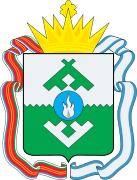Assembly of Deputies of the Nenets Autonomous Okrug
The Assembly of Deputies of the Nenets Autonomous Okrug is the supreme representative and legislative body of the Nenets Autonomous Okrug.[1]
Assembly of Deputies of the Nenets Autonomous Okrug Собрание депутатов Ненецкого автономного округа | |
|---|---|
 | |
| Type | |
| Type | |
| Leadership | |
Chairman | Anatoly Myandin |
| Structure | |
| Seats | 19 |
 | |
Political groups | United Russia (13) Communist Party (3) |
| Elections | |
Last election | 14 September 2014 |
| Website | |
| http://www.sdnao.ru/ | |
It consists of 19 deputies who are elected every four years.[1]
Powers
- Receives district Charter and amendments
- Carries out legislative regulation of subjects of conducting the district and the joint jurisdiction of the Russian Federation and the Russian Federation within the district office
- Hears annual reports of the head of the district administration about its activities and the activities of the district administration
- Exercise other powers established by the Constitution, federal laws, the Charter and laws of the Nenets Autonomous Okrug.[1][2]
Sessions
The main form of work of the Assembly of Deputies is the session. The session is eligible if at least two thirds of the established number of members of parliament take part in its work. Deputies are required to take part in the work of each session. If it is impossible to take part in the meeting for a good reason, the MP shall inform in advance and in writing the Chairman of the Assembly indicating the reasons of the absence. The absence of an MP without solid motivation, unauthorized interruption of his participation at the session work is considered as a violation of the rules of parliamentary ethics and entails the use of influence measures on him.
References
- Assembly of Deputies of the Nenets Autonomous Okrug | http://www.sdnao.ru/information/assembly/
- Constitution of Russia | http://constitution.garant.ru/region/ustav_nenetsk/chapter/5/#block_500